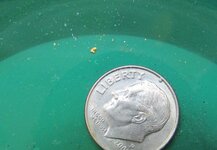brianc053
Hero Member
- Jan 27, 2015
- 987
- 3,443
- 🏆 Honorable Mentions:
- 3
- Detector(s) used
- Minelab Equinox 800
XP Deus 2
- Primary Interest:
- Metal Detecting
Hello Treasurenet! This past weekend my son Andrew and I took our first trip up to New Hampshire, to prospect on the Wild Ammonoosuc River near Bath, NH. We stayed at the Twin River Campground, which tailors to gold prospectors.
Coincidentally we were there the same weekend that a group called the North East Prospectors had their annual kickoff to the season, so the campground was hopping with lots of prospectors. (Thank you Roy for the hospitality!)
We drove up on Friday night and got in after dark. Early Saturday morning we talked to a few of the other prospectors and got some advice. We learned that there were three main locations to prospect:
1. adjacent to the Campground, near the Riverside campsites. This location offers very easy access to the river and a pretty large "bar" on the inside of a curve in the river. This area is for panning and sluicing (no motors).
2. upstream from the campground about a quarter mile, the campground owns additional land - about one mile of riverfront! This area's bank is a little steeper (10-15' drop) but there's parking along the road at various pullouts. This is the area where dredgers and those using high bankers must go (Campground rules).
3. upstream further about 5-10 minutes is the White Mountain National Forest. The National Forest only allows panning and sluicing. The area where we pulled off had a significant bar (about 6 feet thick/deep).
Andrew and I spent our time testing various types of prospecting and talking to others who were using these various methods. My GPAA chapter is taking a group trip up to the same location in June, so I wanted to pass on advice to my club members. Therefore, we weren't focused on just moving lots of material; instead we wanted to try different things and learn about what works and what doesn't up there. Here are my conclusions:
For panning and sluicing: We found that doing this just off the Campground near the Riverside campsites was great. When panning we used a 1/4" classifier in a pan, and we'd shovel into the classifier and use it to remove the larger rocks. We'd pan the remaining sand/dirt. Andrew and I both found flakes in our very first pans. Just about every pan had a color or a few, though some were very small (50-100 mesh). Andrew found the largest flake this way. For the most part I gathered material from downstream of large rocks; I tested in the water and out of the water and had better results in the water, though others there said that the best approach was to move a large dry rock and pan the material under it.
I also ran one five-gallon bucket through the sluice; the material was collected from a rock at the water line. I did not find much more gold in the sluice than I would have in a few pans, but this could have been because the sluice was running a bit "hot" (too steep).
For those who like to dredge or high bank: I didn't do this, but when I go back in June I intend to high bank. With these methods its about moving material, and that area north of the campground has A LOT of material to be moved. There are plenty of places to be dredged. If you have air available you could reach places out in the river that others have probably not gone, but without air it would be tough to dredge deep out in the river, which tends to be 2-3 feet deep before you even start moving overburden. Most of the dredgers were along the bank.
NOTE: you must have a dredge permit from NH state to use a dredge or high banker. The permit costs $50. One is needed for each machine (not for each person, so people can team up).
Other methods: Andrew tried out crevicing (using tools to clean out cracks in the rock) but he didn't like it. I tried it and found it annoying too. There are plenty of cracks, but you'd need to have the right tools and know what you're doing. We didn't find anything this way.
I also used my 1" battery powered Goldsnare dredge. I got a nice flake and some fine gold using it in just one 6" wide crack.
Final thoughts: the campground is nice, the people are nice, the location is great and the gold was really good. Oh, there's very poor cell phone coverage at the campground - so be aware (they do have wifi).
And now for the pictures: (I had a problem with my phone so I didn't take as many pictures as I would have liked to)
A view of the Wild Ammonoosuc River near Bath, NH. From the old bridge near Twin River Campground.
Note the dredge hole on the left.
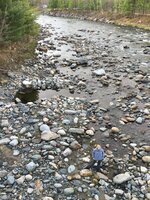
A panorama of a stretch of the Wild AM; this is right next to the Riverside campsites at the Campground:

Andrew found a nice flake in his first pan:
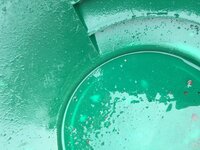
I found this gold in 4 test pans on Sunday morning, before Andrew even woke up!
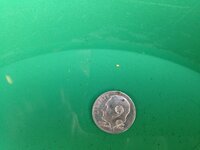
Here's all the gold we found during our 24 hour visit to the Wild AM:
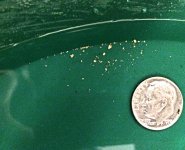
And here's a video I put together from the trip:
(can I embed this as a video? Or is providing a link the only option?)
Coincidentally we were there the same weekend that a group called the North East Prospectors had their annual kickoff to the season, so the campground was hopping with lots of prospectors. (Thank you Roy for the hospitality!)
We drove up on Friday night and got in after dark. Early Saturday morning we talked to a few of the other prospectors and got some advice. We learned that there were three main locations to prospect:
1. adjacent to the Campground, near the Riverside campsites. This location offers very easy access to the river and a pretty large "bar" on the inside of a curve in the river. This area is for panning and sluicing (no motors).
2. upstream from the campground about a quarter mile, the campground owns additional land - about one mile of riverfront! This area's bank is a little steeper (10-15' drop) but there's parking along the road at various pullouts. This is the area where dredgers and those using high bankers must go (Campground rules).
3. upstream further about 5-10 minutes is the White Mountain National Forest. The National Forest only allows panning and sluicing. The area where we pulled off had a significant bar (about 6 feet thick/deep).
Andrew and I spent our time testing various types of prospecting and talking to others who were using these various methods. My GPAA chapter is taking a group trip up to the same location in June, so I wanted to pass on advice to my club members. Therefore, we weren't focused on just moving lots of material; instead we wanted to try different things and learn about what works and what doesn't up there. Here are my conclusions:
For panning and sluicing: We found that doing this just off the Campground near the Riverside campsites was great. When panning we used a 1/4" classifier in a pan, and we'd shovel into the classifier and use it to remove the larger rocks. We'd pan the remaining sand/dirt. Andrew and I both found flakes in our very first pans. Just about every pan had a color or a few, though some were very small (50-100 mesh). Andrew found the largest flake this way. For the most part I gathered material from downstream of large rocks; I tested in the water and out of the water and had better results in the water, though others there said that the best approach was to move a large dry rock and pan the material under it.
I also ran one five-gallon bucket through the sluice; the material was collected from a rock at the water line. I did not find much more gold in the sluice than I would have in a few pans, but this could have been because the sluice was running a bit "hot" (too steep).
For those who like to dredge or high bank: I didn't do this, but when I go back in June I intend to high bank. With these methods its about moving material, and that area north of the campground has A LOT of material to be moved. There are plenty of places to be dredged. If you have air available you could reach places out in the river that others have probably not gone, but without air it would be tough to dredge deep out in the river, which tends to be 2-3 feet deep before you even start moving overburden. Most of the dredgers were along the bank.
NOTE: you must have a dredge permit from NH state to use a dredge or high banker. The permit costs $50. One is needed for each machine (not for each person, so people can team up).
Other methods: Andrew tried out crevicing (using tools to clean out cracks in the rock) but he didn't like it. I tried it and found it annoying too. There are plenty of cracks, but you'd need to have the right tools and know what you're doing. We didn't find anything this way.
I also used my 1" battery powered Goldsnare dredge. I got a nice flake and some fine gold using it in just one 6" wide crack.
Final thoughts: the campground is nice, the people are nice, the location is great and the gold was really good. Oh, there's very poor cell phone coverage at the campground - so be aware (they do have wifi).
And now for the pictures: (I had a problem with my phone so I didn't take as many pictures as I would have liked to)
A view of the Wild Ammonoosuc River near Bath, NH. From the old bridge near Twin River Campground.
Note the dredge hole on the left.

A panorama of a stretch of the Wild AM; this is right next to the Riverside campsites at the Campground:

Andrew found a nice flake in his first pan:

I found this gold in 4 test pans on Sunday morning, before Andrew even woke up!

Here's all the gold we found during our 24 hour visit to the Wild AM:

And here's a video I put together from the trip:
(can I embed this as a video? Or is providing a link the only option?)
Last edited:
Upvote
0


